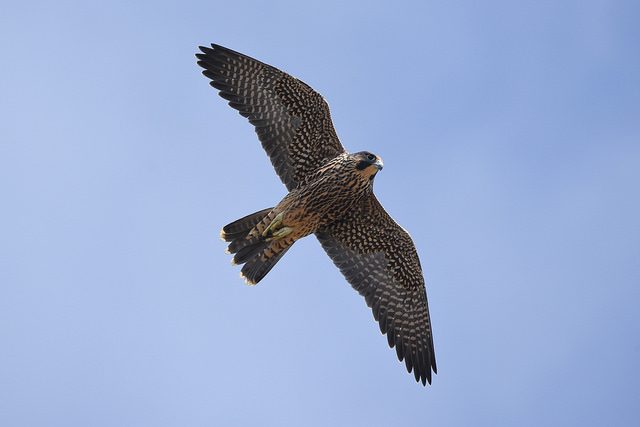
Winter solstice marks the time of year when male and female peregrine falcons begin bonding, courting, and mating. While out hiking in Cabrillo during the winter season, you may see a feathered pair performing aerobatics, specifically the male, as he tries to impress the female with his physical prowess. This is also about the time when the falcons are looking for an ideal spot for a nest, also referred to as a “scrape.” Since peregrines usually don’t build a nest with sticks and twigs; they find an ideal depression or cavity on a cliff and clear -- or “scrape”-- it out. We’re hoping that the pair that nested at Cabrillo last year comes back this season. This is pretty likely, as peregrine falcon pairs generally have a high “site fidelity”, meaning, once they find a place they like, they’ll return again and again.
The male will soon begin hunting for the female as well as for himself. Her job will be to work on building up her fat reserves so that she can produce eggs. The female that nested here last year had 3 fledglings (young that have successfully left the nest), while in 2015, the same female had 4 young that successfully fledged. An average female can produce 2-5 eggs. Not too long ago though, peregrine falcons in Point Loma and elsewhere didn’t have it this good.

Populations of peregrines were decimated between the 1950s and 1970s due to DDT poisoning, a pesticide widely used in agriculture. The last pair observed in Point Loma prior to the DDT disaster was in 1948. This chemical causes egg shell thinning, which greatly reduced hatching success. Peregrine falcons at Cabrillo have had a lot of success in recent years, and they have come a long way since their endangered status thanks to conservation efforts that have been put in place, like banning the chemical DDT.
Another factor contributing to their comeback is from a reintroduction program in the 1980s. The collaborative effort between the Santa Cruz Predatory Bird Research Group and the Peregrine Fund released 12 birds between 1982 and 1988 from the Point Loma peninsula.
Are our resident peregrines descendants of the birds that were released back in the 1980s? We’re not sure. But what we do know is that they have established themselves in this area once again and appear to be thriving.
Sources: Dr. Joel Pagel, USFWS; allaboutbirds.org;
